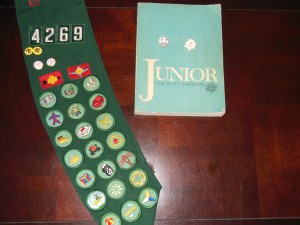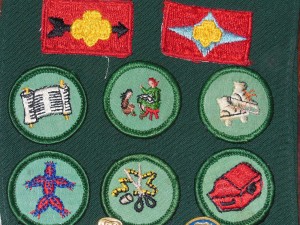Returning to the Craft

How does one figure out what to do professionally? A successful woman executive advised in an article I read that if you are unsure about your career path, do the following exercise: think about the first badge you earned as a Girl Scout. The first badge you chose to work on – not the leather tooling one that was foisted on the entire troop by your leader — is a strong indicator of your innate interests and skills. Children naturally gravitate towards activities they enjoy and which they are good at. The badge is a clue to a professional path in which you are likely to find success and personal satisfaction.

Junior Girl Scout badges circa 1973
From left to right
Top row: Sign of the Arrow, Sign of the Star
Middle row: Writer, Storyteller and Skater
Bottom row: Toymaker, Sewing and Collector
The executive’s thesis resonated with me. (Unfortunately, I have not been able to find this article despite multiple Google searches. If you know it, please let me know.) My first Girl Scout badge – earned as a junior scout in Troop 4269 in Queens – was Writer, quickly followed by Storyteller. I earned Writer by writing in a journal, rewriting a favorite story as a play, and reading a book on the art of writing. For the Storyteller badge, I kept a notebook of stories to tell, and read several anthologies of folk tales and mythologies. While many children dislike writing (Exhibit A: my son), I loved it. I started writing fictional stories in notebooks when I was in fourth grade, announced that I wanted to be a journalist in sixth grade, and steadfastly pursued that career when I graduated from college. My first job was as reporter for a venture capital publication, interviewing the founders of start-up companies, many in the technology field. It was fun to talk to individuals who poured everything they had – money, skill and labor — into their ideas and innovations.
After a couple of years doing reporting, rewriting, copy editing and editing various publications, I landed what I then considered as my dream job at Newsweek magazine. My job title was senior editorial assistant, although some of my colleagues used the euphemism “reporter-researcher.” In essence, I was a fact checker who occasionally had the opportunity to do some reporting, mostly on business and finance.
I can’t say that I enjoyed fact-checking. But I stayed at it for the chance to win a general assignment reporting internship at one of Newsweek’s bureaus. I went to Houston for the summer (Who did you piss off to get sent to Houston in July? my husband asked), where I had the opportunity to report on some stories I personally cared about, including elder abuse and the under-education of latinos.
On the flip side, I also had to do some work which I found distasteful. I remember, for example, being assigned to call the spokesperson for Lady Bird Johnson, the widow of President Johnson, to ask for a comment about rumors of extramarital affairs swirling around her son-in-law, Senator Chuck Robb. Then there came what I now call my Demi Moore moment. Moore famously appeared naked and pregnant on the cover of Vanity Fair magazine. My assignment was to get people-on-the street reaction. I spent a day wandering the underground passageway in Houston (it was too hot for anyone to be outside), holding the magazine up and asking people what they thought. Not exactly serious journalism.
At that point, I decided I had gotten far afield from what I wanted to accomplish in a career in journalism. So I switched professions. Now I am a public interest attorney and I find great reward in my work. I’ve known journalists who’ve become lawyers and vice versa, because the skill sets of the two professions are so similar — one needs to quickly become an expert on a new topic, research it to death, and then write under deadline. But I missed the personal reward that writing, particularly fiction writing, gave me as a child.
I’ve recently returned to the craft of fiction writing because I want to reconnect with the same passion that prompted me to to work on those badges forty years ago. Terrific teachers, workshop leaders and fellow writers inspire and encourage me to write, and the resulting work gives me a sense of accomplishment unlike what I find through any other pursuit. In graduate level creative writing courses and, most recently, a writer’s group, I’ve discovered that sharing my work pieces others – whether it’s by circulating a draft for people to read, or just reading out loud from my notebook – is also immensely gratifying. I love to hear from a reader (or listener) about what resonates with them, what works, what doesn’t, how a phrase reminds them of something they’ve forgotten, or evokes a certain emotion. And it’s for that reason that I’ve started this blog — to hear from more readers. So please stay tuned for my posts on various topics — including the craft of writing, political and social issues, and pieces of fiction — and let me know what you think.
Next post: Creating mental space

